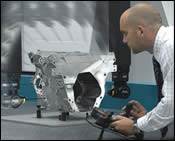How Stylus Choice Affects CMM Accuracy
Measurement uncertainty and inconsistency can result when an improper CMM stylus is chosen. A metrology products manufacturer details four aspects of stylus choice that can impact overall CMM accuracy.
The stylus is the critical link between a CMM’s measurement sensor and the surface of the workpiece being inspected. Simply put, measurement uncertainty and inconsistency can result when an improper CMM stylus is chosen for a given application. Renishaw, UK-based manufacturer of metrology products, explains how the following four aspects of stylus choice can impact overall CMM measurement accuracy.
● Tip roundness—The measuring tips of most styli feature a synthetic ruby ball. Errors in ball roundness can cause a CMM to lose as much as 10 percent of its potential measurement accuracy. Ruby stylus balls are defined by grades, manufactured to levels of precision related to the maximum deviation of a ball from a perfect sphere. The two most common ball specifications are grades 5 and 10 (sphericity of grade 5 and 10 balls is 0.13µm and 0.25µm, respectively). Although switching from grade 5 balls to grade 10 balls offers some cost savings, the commonly accepted 5:1 ratio of CMM uncertainty to feature tolerance can be compromised. Standardizing on grade 5 balls may cost a bit more, but that cost can be minor compared to potentially scrapping a good part or passing one that’s non-conforming.
● Tip material—Although ruby is the most commonly used stylus ball material, other materials may be better suited for scanning routines. A stylus ball slides across the workpiece surface during scanning routines, resulting in frictional wear. In extreme circumstances, this prolonged contact can cause tip material to be removed from the ball (abrasive wear) or workpiece material to be deposited onto the ball (adhesive wear). Either situation impacts tip roundness. This is magnified when one portion of the ball remains in constant contact with the workpiece.
Abrasive wear can occur when scanning a material such as cast iron. Tiny particles of residue can cause minute scratches on both the ball and workpiece, generating a small “flat” on the ball. For these applications, tougher zirconia balls are a good choice. Alternately, adhesive wear happens when a chemical affinity exists between the stylus ball and the workpiece material. This is common when scanning aluminum parts using a synthetic ruby ball, because synthetic ruby is primarily composed of aluminum oxide. Any material that passes from the relatively soft aluminum workpiece to the ball generates a coating that diminishes the ball’s roundness accuracy. In these cases, a ball made of silicon nitride is the better choice, as that material demonstrates good wear resistance and is not attracted to aluminum.
● Stylus bending—Measurement accuracy diminishes with increased stylus length, which is why a long stylus isn’t appropriate for measuring all workpiece features. (In fact, it’s good practice to use a stylus that is as short as possible for maximum stiffness.) The stylus is not directly responsible for this particular error, but the error is magnified with stylus length. The error is caused by pre-travel variation originating from differing forces required to trigger the probe as it contacts a workpiece from different directions. Probe calibration on a reference sphere minimizes this pre-travel error, but doesn’t eliminate it.
Stylus flexibility magnifies pre-travel variation. While steel is suitable for some short styli, tungsten carbide is the stiffest styli material. The density of tungsten carbide precludes it from being used on long styli, however. Ceramic styli are often used for probing applications requiring both stiffness and light weight. Similarly, carbon fiber is commonly used for very long styli.
● Thermal stability—Temperature fluctuations can cause significant CMM measurement errors. The proper material for stylus extensions can yield better stability under changing environmental conditions, delivering more consistent measurement results. Materials with a low coefficient of thermal expansion are preferred, especially when long styli are being used because thermal growth is length-dependent. Carbon fiber is most commonly used for long styli and extensions because that material is stiff and light. Titanium provides the best combination of strength, stability and density when metals are needed for stylus components such as joints and knuckles.
Related Content
Ballbar Testing Benefits Low-Volume Manufacturing
Thanks to ballbar testing with a Renishaw QC20-W, the Autodesk Technology Centers now have more confidence in their machine tools.
Read MoreHow to Calibrate Gages and Certify Calibration Programs
Tips for establishing and maintaining a regular gage calibration program.
Read More6 Machine Shop Essentials to Stay Competitive
If you want to streamline production and be competitive in the industry, you will need far more than a standard three-axis CNC mill or two-axis CNC lathe and a few measuring tools.
Read More4 Ways to Establish Machine Accuracy
Understanding all the things that contribute to a machine’s full potential accuracy will inform what to prioritize when fine-tuning the machine.
Read MoreRead Next
Revving Up The CMM
High speed, five-axis scanning promises to give throughput on coordinate measuring machines a big boost. Entire manufacturing strategies may be up for rethinking as a result.
Read More3 Mistakes That Cause CNC Programs to Fail
Despite enhancements to manufacturing technology, there are still issues today that can cause programs to fail. These failures can cause lost time, scrapped parts, damaged machines and even injured operators.
Read More
.jpg;width=70;height=70;mode=crop)









.png;maxWidth=300;quality=90)














